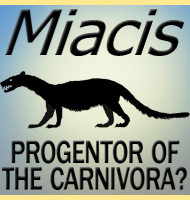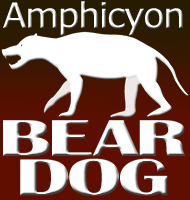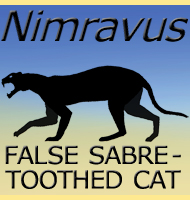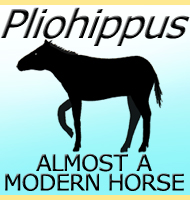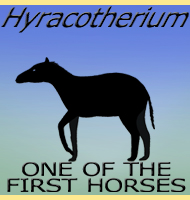


Enaliarctos
Name:
Enaliarctos
(Sea bear).
Phonetic: En-al-e-ark-tos.
Named By: Mitchell & Thedford - 1973.
Classification: Chordata, Mammalia, Carnivora,
Pinnipeda, Enaliarctidae.
Species: E. mealsi (type),
E.
barnesi, E. emlongi, E. mitchelli, E. tedfordi.
Diet: Carnivore.
Size: Around 1.5 meters long.
Known locations: USA, California and Oregon.
Time period: Chattian of the Oligocene to Early
Miocene.
Fossil representation: Many specimens.
Enaliarctos
has been commonly included in books about prehistoric animals where it
is credited as being the first pinniped, the groups that seals, sea
lions and walruses all belong to. The 2009 description of Puijila
however has taken some of the limelight away since this is even more
primitive pinneped in form that more clearly shows the transition
between land living ancestors and more aquatic descendants. One often
overlooked fact however is that some remains of Enaliarctos
actually
come from the late Oligocene period which means that they actually
predate the Puijila type specimen. Despite this Puijila
almost
certainly does represent a more primitive form of pinneped than
Enaliarctos, but it does suggest that they
continued to survive in
their existing form despite the advancements made by other genera such
as Enaliarctos.
One
key area of study concerning Enaliarctos is how it
swam. Today sea
lions and fur seals (those with external ears) swim with only their
front limbs, while true seals (those with just ear holes rather
than eternal ear lobes) swim with only the rear limbs. Enaliarctos
however seems to have swum with both fore and hind limbs, an idea
supported by biomechanical study. This indicates that as early
pinnepeds evolved to be better suited to swimming they initially swam
with all fore limbs until they specialised down one form of locomotion
other the other.
Aside
from locomotion another trait that reveals the primitive nature of
Enaliarctos is the dentition. Modern pinnepeds
have teeth for
crunching and puncturing, but Enaliarctos also
retained slicing teeth
towards the back of the mouth. This has been taken as an indication
that would have had to return to land to eat the animals that it caught
at sea. Enaliarctos was well adapted for hunting
under water as
evidenced by spaces for large eyes, well developed whiskers and
hearing that had developed to work well under the water.
Further reading
- The Enaliarctinae: A new group of extinct aquatic Carnivora and a
consideration of the origin of the Otariidae. - Bulletin of the
American Museum of Natural History, 151(3), 203-284. - E. Mitchell
& R. H. Tedford - 1973.
- Skeleton of the oldest known pinniped, Enaliarctos mealsi.
- Science
244:60-62. - A. Berta, C.E. Ray & A.R. Wyss - 1989.
- New Enaliarctos* (Pinnipedimorpha) from the
Miocene of Oregon and the
role of "Enaliarctids" in Pinniped Phylogeny. - Smithsonian
Contributions to Paleobiology 69. - A. Berta - 1991.
Random favourites
 |
 |
 |
 |
